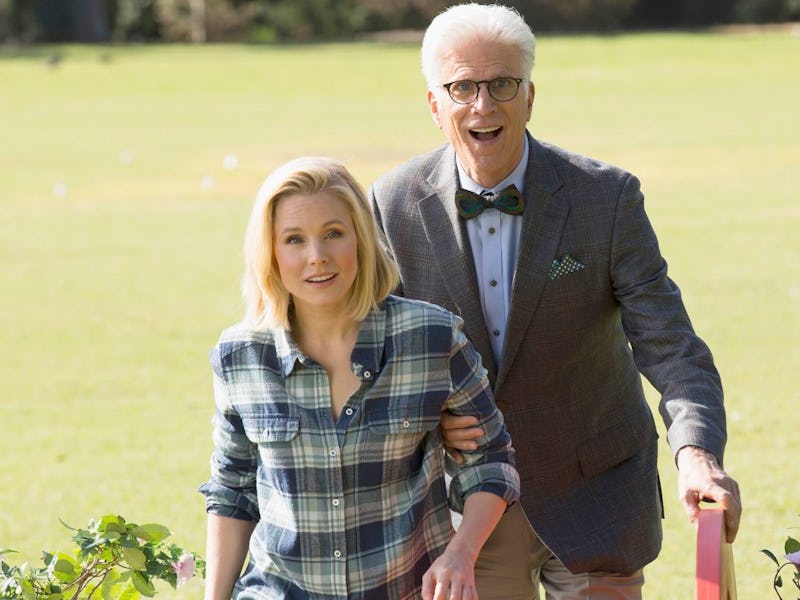Why 'The Good Place' Is the Must Watch Fall TV Show
It looks like a standard sitcom, but it's actually 'The Leftovers'-light, in a good way.

From the outside, The Good Place looks like a fairly standard sitcom: Its posters feature fresh-faced, beaming white people in an odd-couple buddy dynamic. You can practically hear the plain, non-offensive jokes hiding the occasional subversive zinger, all lined by a laugh track. But as it turns out, that subversive zinger is the core of the show. And it all connects to Damon Lindelof, the guy whose name you shake your fist at because he ruined Lost — that is, if you’re not a Leftovers fan.
The premise of The Good Place — that Kristen Bell’s Eleanor has died and accidentally ended up in a vaguely non-denominational afterlife for saintly people, even though she was an average-to-mediocre person in life — is charmingly bonkers. She must hide this case of mistaken identity from her angelic guide, played by Ted Danson, lest he kick her out and send her to the ominous-sounding Bad Place.
The pilot does deliver on the promise of the teasers and the poster. It begins as light and bubbly as champagne, with a fairly lame joke about how Eleanor died, but shifts into something deeper about fifteen minutes in (once we find out her true nature). By the end, it evokes laughs, but it’s also provocative and creates an intriguing existential setup.
That’s where Damon Lindelof comes in: He doesn’t have a hand in the show, but Good Place creator Mike Schur consulted with him for advice while it was in development.
Before you throw your hands up and back away, yes, Damon Lindelof knows he fucked up the afterlife in Lost. He’s owned up to his mistakes, and best of all, he’s actually learned from them. No matter how much you hated Lost, it’s impossible not to recognize what a masterpiece The Leftovers’s episode “International Assassin” is. It’s the most thoughtful and moving depiction of an afterlife that’s ever happened on television. That sounds hyperbolic, but just watch it. Seriously.
The Leftovers as a whole is among the best of the best, but it’s also heavy as hell and deeply weird. The first episode of its second season starts with a bizarre and unexplained prologue about a cavewoman; the rest of the episode follows an entirely new cast of characters while the protagonists don’t appear until near the ending. The series includes cults, lots of crying, female-on-male rape, and goat sacrifices in diners. It’s the most deeply human show on television but its dark tone and deep-dive into depression is not something everyone can stomach. It’s harsh, aggressive, and unforgiving; sometimes, it’s more of a thought-experiment-cum-art-film-series than a standard television show.
Enter The Good Place. It explores similar themes in a way that’s more palatable for mass audiences. It explores questions like “What does it all mean?” and “Why am I here?” in a tongue-and-cheek way that has its cake and eats it too. Kristen Bell’s Eleanor is an unapologetically brash heroine in the Broad City model, and the rest of the cast is nonchalantly diverse as you’d expect an afterlife to actually be — no sci-fi movie bullshit where everyone in the future is inexplicably white. And just like The Leftovers, it doesn’t take itself too seriously.
The Good Place is watchable for the whole family in way that the former show isn’t. To call it Leftovers-light sounds like an insult, but it isn’t. In an ideal world — in a world that was truly The Good Place — everyone would watch The Leftovers. But for those who can’t — or even for those who can but want some variety — The Good Place is the most human, charming, creative new show this fall.
The Good Place airs on Monday the 19th on NBC.